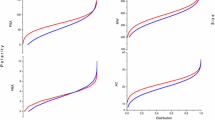Abstract
Dihydrofolate reductase has successfully been used as a drug target in the area of anti-cancer, anti-bacterial and anti-malarial chemotherapy. Little has been done to evaluate it as a drug target for treatment of the trypanosomiases and leishmaniasis. A crystal structure of Leishmania major dihydrofolate reductase has been published. In this paper, we describe the modelling of Trypanosoma cruzi and Trypanosoma brucei dihydrofolate reductases based on this crystal structure. These structures and models have been used in the comparison of protozoan, bacterial and human enzymes in order to highlight the different features that can be used in the design of selective anti-protozoan agents. Comparison has been made between residues present in the active site, the accessibility of these residues, charge distribution in the active site, and the shape and size of the active sites. Whilst there is a high degree of similarity between protozoan, human and bacterial dihydrofolate reductase active sites, there are differences that provide potential for selective drug design. In particular, we have identified a set of residues which may be important for selective drug design and identified a larger binding pocket in the protozoan than the human and bacterial enzymes.
Similar content being viewed by others
References
Filman, D.J., Bolin, J.T., Matthews, D.A. and Kraut, J., J. Biol. Chem., 257 (1982) 13663.
Reyes, V.M., Sawaya, M.R., Brown, K.A. and Kraut, J., Biochemistry, 34 (1995) 2710.
Blaney, J.M., Hansch, C., Silipo, C. and Vittoria, A., Chem. Rev., 84 (1984) 333.
Knighton, D.R., Kan, C.C., Howland, E., Janson, C.A., Hostomska, Z., Welsh, K.M. and Matthews D.A., Nat. Struct. Biol., 1 (1994) 186.
Reche, P., Arrebola, R., Olmo, A., Santi, D.V., Gonzales-Pakanowska, D. and Ruiz-Perez, L., Mol. Biochem. Parasitol., 65 (1994) 247.
Gamarro, F., Yu, P.L., Zhao, J., Edman, U., Greene, P.J. and Santi, D., Mol. Biochem. Parasitol., 72 (1995) 11.
Ivanetich, K.M. and Santi, D.V., FASEB J., 4 (1990) 1591.
Li, Z., Chen, X., Davidson, E., Zwang, O., Mendis, C., Ring, C.S., Roush, W.R., Fegley, G., Li, R., Rosenthal, P.J., Lee, G.K., Kenyon, G.L., Kuntz, I.D. and Cohen, F.E., Chem. Biol., 1 (1994) 31.
Toyoda, T., Brobey, R.K.B., Sano G., Horii, T., Tomioka, N. and Itai, A., Biochem. Biophys. Res. Commun., 235 (1997) 515.
Bernstein, F.C., Koetzle, T.F., Williams, G.J.B., Meyer, E.F., Brice, M.D., Rodgers, J.R., Kennard, O., Shimanouchi, T. and Tasumi, M., J. Mol. Biol., 112 (1977) 535.
Needleman, S.B. and Wunsch, C.D., J. Mol. Biol., 48 (1970) 443.
Martin, A.C.R., NW, unpublished data.
Felsestein, J., Cladistics 5, 164.
Sali, A. and Blundell, T.L., J. Mol. Biol., 234 (1993) 779.
Laskowski, R.A., MacArthur, M.W., Moss, D.S. and Thornton, J.M., J. Appl. Crystallogr., 26 (1993) 283.
Taylor, W.R., J. Mol. Evol., 28 (1988) 161.
CAMELEON, Oxford Molecular, Oxford, U.K.
McLachlan, A.D., Acta Crystallogr., A38 (1982) 871.
Martin, A.C.R., ProFit, unpublished data.
MACROMODEL, Colombia University, New York, NY, U.S.A.
QUANTA, Molecular Simulations, Burlington, MA, U.S.A.
Nicholls, A., Bharadwaj, R. and Honig, B., Biophys. J., 64 (1993) A166.
Sayle, R, RASMOL, Glaxo Wellcome.
Lee, B. and Richards, F.M., J. Mol. Biol., 55 (1971) 379.
Hubbard, S., ACCESS, EMBL.
Laskowski, R., J. Mol. Graph., 13 (1995) 323.
Morris, A.L., MacArthur, M.W., Hutchinson, E.G. and Thornton, J.M., Proteins, 12 (1992) 345.
Ramachandran, G.N., Ramakrishnan, C. and Sasisekharan, V., J. Mol. Biol., 7 (1963) 95.
Martin, A.C.R., MacArthur, M.W. and Thornton, J.M., Proteins Struct. Funct. Genet., in press.
Oefner, C., D'Archy, A. and Winkler, F.K., Eur. J. Biochem., 174 (1988) 377.
Bolin, J.T., Filman, D.J., Matthews, D.A., Hamlin, R.C. and Kraut, J., J. Biol. Chem., 257 (1982) 13650.
Champness, J.N., Stammers, D.K. and Beddell, C.R., FEBS Lett., 199 (1986) 61.
Champness, J.N., Achari, A., Ballantine, S.P., Bryant, P.K., Delves, C.J. and Stammers, D.K., Structure, 2 (1994) 915.
Author information
Authors and Affiliations
Rights and permissions
About this article
Cite this article
Zuccotto, F., Martin, A.C., Laskowski, R.A. et al. Dihydrofolate reductase: A potential drug target in trypanosomes and leishmania. J Comput Aided Mol Des 12, 241–257 (1998). https://doi.org/10.1023/A:1016085005275
Issue Date:
DOI: https://doi.org/10.1023/A:1016085005275




